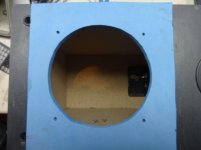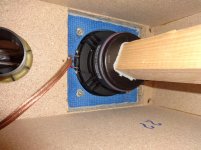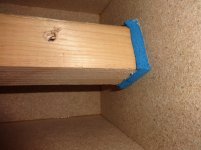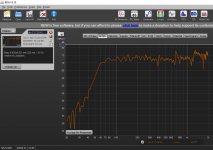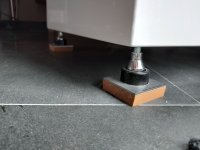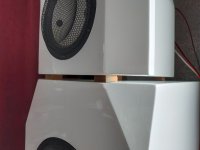Yes. The energy to excite the resonance has to be in much narrower bandwidth over a much longer time to pump the correct energy into the panel sufficiently to make the reonance go off. A situation not often met by music if you can raise the potential box resonances high enuff.

dave
dave
Attachments
This "simple" Idea HAS been used through the decades. Kef in particular. Bolt the magnet, just a foam gasket to the baffle. If a sealed enclosure, it needs to be pretty stiff foam though or you will blow past it. Two features for one. You de-couple from the baffle and two, the magnet is held sturdy so the motor has a better position to push from. All around a good idea. Easy on a ported box as you don't have the pressure problem. Why is it not common? It is expensive, but DIY is more common.
Similar, you don't see subs opposing bolted together and to the base with "floating " baffles. Again, not uncommon in DIY.
Similar, you don't see subs opposing bolted together and to the base with "floating " baffles. Again, not uncommon in DIY.
Coming back to the resonance of the decoupled driver, we want to get it as low as possible for a full range driver, if we can't easily get it below the pass band then we could use some EQ if it effects the frequency response detrimentally and the lower in frequency it is the more successful it would be, yes/no?
Coming back to the resonance of the decoupled driver, we want to get it as low as possible for a full range driver, if we can't easily get it below the pass band then we could use some EQ if it effects the frequency response detrimentally and the lower in frequency it is the more successful it would be, yes/no?
As long as the resonance is (sufficiently) below the passband, you don't have to worry about it. It won't be excited.
For example, in my drivers-on-wires approach, the resonance would be much like a pendulum system. It's surprising that a short (few inches) wire results in a resonant frequency of 2Hz or less. That's way below the passband. Mass does not influence the resonant frequency at all, it's only dependent on the pendulum length. This is why I like wire suspension over support via the magnet for decoupling.
I wondered about that, the pendulum frequency would be the only resonance, I suppose it must be? The magnet mount is a second best solution to free hanging as per the test I posted I think.
I take your point, but it's chancing it a bit and rather music dependant.
It is, but how much music has intense, continuous (say) > 500 Hz tones?
I keep trying to find some. You know any?
If you want to be anal you could tune the (potential) resonances between notes used in the well-tempered scale, then you would be pretty safe. But just pushing them up in frequency to a point where there is much less energy being put into the panels, and the panels are that much thicker compared to the wavelength involved is as far as i take it.
Here a graph generated to give an idea of how much the frequency changes the input into the panels.
It shows the relative energy available to excite a resonance relative to a likelihood of 1 at 300 Hz. 300 Hz was choosen because this is considered the typical point where half the energy in the music is above, and half the energy below, and is key to one of the suppositions that leads to a 1/forth power.
A/ 1/second power falls out of the way a cone driver works to mantain flat frequency response
I argue that we can achieve the 4th power by considering:
B/ the "quantity" of music falls with increase in frequency
C/ the effectiveness of the panel material's damping increase as the wavelength decreases vrs material thickness
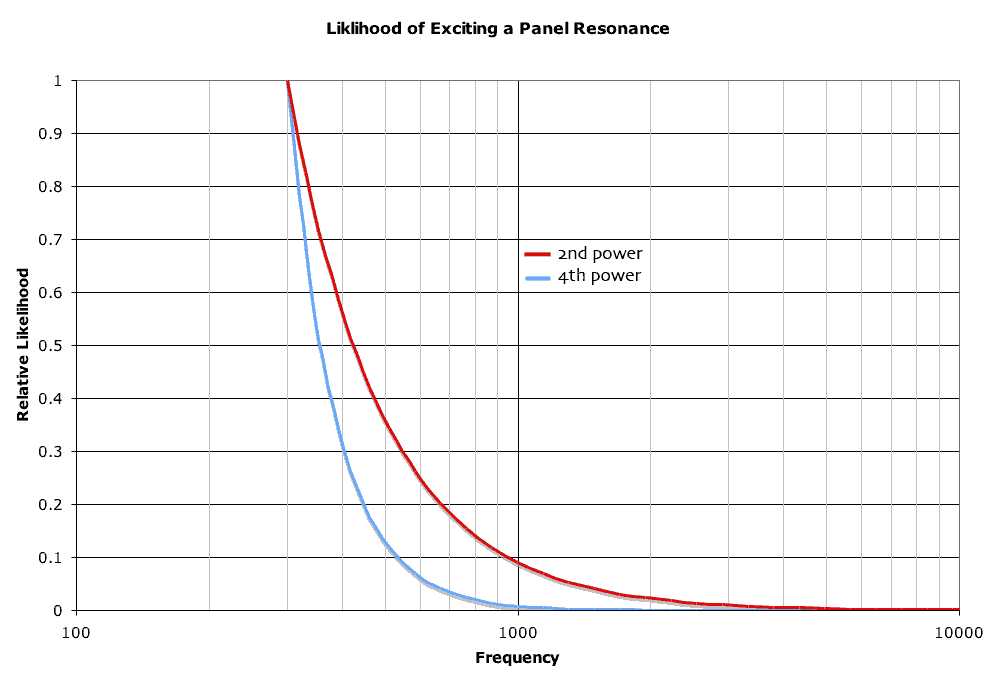
dave
Yes. The energy to excite the resonance has to be in much narrower bandwidth over a much longer time to pump the correct energy into the panel sufficiently to make the reonance go off. A situation not often met by music if you can raise the potential box resonances high enuff.
dave
I think this is entirely wrong. A high Q resonance is much more audible, and any resonance may be excited by any impulse energy not in the resonance's band, and low Q implicitly means higher self damping.
If you strike a bell with a hammer, the ring is relatively independent of the nature and structure of the hammer's own resonances, but the impulse excites the bell resonance.
Further, the BBC deliberately designed very loose low Q boxes, to displace resonances to a less objectionable range lower in the spectrum.
If you want to be anal you could tune the (potential) resonances between notes used in the well-tempered scale, then you would be pretty safe.
I doubt that would be possible, besides my music taste isn't that narrow. Simpler to decouple the driver, and no downsides that I've yet found.
If the energy is not transferred to the panels, it is reflected directly back into the cone. That is of course also the case with bog standard speakers.
A somewhat compliant suspension of the driver would absorb a lot of the energy going into the basket and not return it to the cone with all the interference effects that would suggest.
Perhaps better directivity characteristics could be achieved for FR drivers?
A somewhat compliant suspension of the driver would absorb a lot of the energy going into the basket and not return it to the cone with all the interference effects that would suggest.
Perhaps better directivity characteristics could be achieved for FR drivers?
If you strike a bell with a hammer, the ring is relatively independent of the nature and structure of the hammer's own resonances, but the impulse excites the bell resonance.
And what happens if you never hit it?
An impulse has all frequencies. Only the one that matches the bell’s potential resonance cause it to ring. Music does not usually have a similar impulse in it.
It doesn’t matter if there are potential resonances if you never excite them.
Toole has stated that low Q resonances are more audiable than high Q ones.
dave
"It doesn’t matter if there are potential resonances if you never excite them."
Yes it does as the well known problems with mag alloy mid/bass cones of a few years ago illustrate; terrible ringing way above band.
Consider then a stretched spring, like a chest expander, which is displaced away from its rest position, and then released; the resulting noise will be entirely dependant on the characteristics of the spring and not related to the cause.
Yes the BBC stated that a band of 4k and of 0.1dB was audible, but one serious high Q resonance can stick out like a sore thumb.
Yes it does as the well known problems with mag alloy mid/bass cones of a few years ago illustrate; terrible ringing way above band.
Consider then a stretched spring, like a chest expander, which is displaced away from its rest position, and then released; the resulting noise will be entirely dependant on the characteristics of the spring and not related to the cause.
Yes the BBC stated that a band of 4k and of 0.1dB was audible, but one serious high Q resonance can stick out like a sore thumb.
Last edited:
If the energy is not transferred to the panels, it is reflected directly back into the cone.
The worst possible scenario.
If the energy is not transferred to the panels, it is reflected directly back into the cone.
Most of the energy that can excite a panel is from the reactive force of the driver on th ebox, very little if any comes from the inner air space. And you have damping in the box to try to kill anything that would come back thru the cone.
And even if significant enegy is transferred from the airspace, it will only be at those frequencies that the panels resonate at, creating a wave impinging on the driver that is only missing those specific frequencies, but now those are coming thru the panels. Given the complexity of that hard to say if one could gain any benefit from that without build a box and test it. And the results will only apply to that box.
dave
Here's some pics of what I've done with this old Kef Q30 cab. Need some tips on measuring this speaker in a room (it's raining and wont stop); the further back and higher off the floor for both speaker and mic, the worse it looks...
I'm interested in seeing detrimental effects of the driver mounting in the measurement and / or the resonance of the now "suspended" driver.
I'm interested in seeing detrimental effects of the driver mounting in the measurement and / or the resonance of the now "suspended" driver.
Attachments
If the energy is not transferred to the panels, it is reflected directly back into the cone. That is of course also the case with bog standard speakers.
That can also be mitigated by making internal dimension, particularly the depth, as short as possible so any reflections are high in frequency and more easily absorbed.
True, I can't wait to see your first decoupled driver speaker design. Seems to me you are missing a business opportunity. 🙂It doesn’t matter if there are potential resonances if you never excite them.
I used Sylomer in my speakers to decouple the mid-high cabinet from the bass cabinet and that one from the floor.
So that the most obstructive bass vibrations doesn't reach the mid/high
Sylomer is one of the best vibration isolation materials.
It's is a high quality polyurethane foam
I use it for all vibration absorbing: speakers, amplifiers, transformers, ...
It's 100% safe for wood, it leaves no marks and is stable in time.
It comes in 10 different stiffness/load
For my speakers I used the brown SR110 that works optimal with a pressure of 0.7kg/cm²
For 70kg(one speaker) in SR110(0.7kg/cm²) I used 100cm², that are 4 pads SR110 of 5x5cm for each speaker.
So that the most obstructive bass vibrations doesn't reach the mid/high
Sylomer is one of the best vibration isolation materials.
It's is a high quality polyurethane foam
I use it for all vibration absorbing: speakers, amplifiers, transformers, ...
It's 100% safe for wood, it leaves no marks and is stable in time.
It comes in 10 different stiffness/load
For my speakers I used the brown SR110 that works optimal with a pressure of 0.7kg/cm²
For 70kg(one speaker) in SR110(0.7kg/cm²) I used 100cm², that are 4 pads SR110 of 5x5cm for each speaker.
Attachments
Consider then a stretched spring, like a chest expander, which is displaced away from its rest position, and then released; the resulting noise will be entirely dependant on the characteristics of the spring and not related to the cause.
That sounds like good reasoning but wouldn't the release be equivalent to an impulse?
- Home
- Loudspeakers
- Full Range
- Softly coupling a driver to the cabinet

